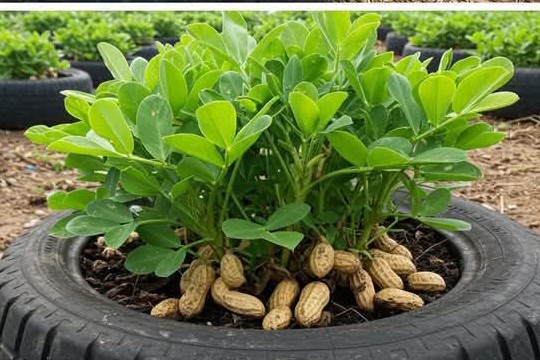Peanuts, otherwise known as groundnuts, aren’t just a tasty, protein-rich snack—they’re also an easy crop to grow at home. Packed with healthy fats and essential nutrients, peanuts make a nutritious addition to any diet. But what if you don’t have garden space? The answer: grow them in old tires! This innovative method is simple, eco-friendly, and ideal for small spaces like patios, balconies, or compact backyards.
If you’d discovered this earlier, you could’ve saved money on store-bought peanuts and enjoyed a fresh, organic harvest from your own home. Let’s walk through the step-by-step process and explore why this method is worth trying.
Why grow peanuts in old tires?
Using old tires as planting beds offers several advantages:
- Space-Saving: Ideal for urban gardeners and tight spaces.
- Heat Retention: Tires absorb and retain heat, promoting faster growth.
- Improved Drainage: Prevents waterlogging, which can harm peanut roots.
- Eco-Friendly: Gives new life to waste tires, reducing landfill load.
- Stackable Design: Add depth by stacking tires, even on poor soil.
Step-by-step guide
1. Choose and prepare your tires
Select old tires that are clean and weathered. Scrub them with soap and water to remove dirt. If desired, apply a non-toxic sealant inside for added safety.
Place the tires in a sunny spot—peanuts need 6–8 hours of sunlight daily.
2. Prepare the soil
Peanuts prefer loose, sandy, well-draining soil.
- Mix garden soil, sand, and compost in a 2:1:1 ratio.
- Fill the first tire with 6–8 inches of this mix.
- Avoid heavy clay, which can hinder pod development.
3. Plant the seeds
Use raw, untreated peanuts—either from a garden store or organic grocery.
- Soak seeds overnight to encourage sprouting.
- Plant 1–2 inches deep, spacing them 6 inches apart.
- Cover lightly with soil and water gently.
- Keep the soil moist (not soggy) for 7–10 days until germination.
4. Care and maintenance
Peanut plants are low-maintenance but need some care:
- Water regularly, especially during flowering and pegging (when stems push into the soil to form pods).
- Mulch with straw or dry leaves to retain moisture and suppress weeds.
- Fertilize using compost or a calcium- and phosphorus-rich organic fertilizer.
- Stack Tires as plants grow—add a new tire and more soil to encourage more pods.
5. Natural pest and disease control
- Aphids & Spider Mites: Spray with neem oil or a garlic-soap solution.
- Fungal Issues: Ensure good airflow and avoid overwatering.
- Rodents & Birds: Use mesh netting to protect plants if needed.
6. Harvesting
Peanuts mature in 4–5 months. Harvest when leaves yellow and wilt.
- Gently dig around the base and pull up the plant.
- Shake off soil and let the peanuts dry in a shaded, airy place for 1–2 weeks.
- Once dried, they’re ready to roast, store, or enjoy fresh!
How this method saves you money
Growing peanuts in tires offers both sustainability and savings:
- No Costly Raised Beds: Tires are often free or inexpensive.
- Water Efficiency: Tires help retain moisture, lowering water usage.
- Free Peanuts: One plant yields dozens of pods.
- Low Fertilizer Costs: Compost and natural inputs are budget-friendly.
- Chemical-Free Pest Control: Homemade solutions cut pesticide expenses.
Final thoughts
With this clever method, you can grow organic peanuts without a traditional garden—while repurposing waste and reducing costs. It’s low-maintenance, beginner-friendly, and perfect for anyone wanting to garden more sustainably.
So why wait? Grab some old tires, plant a few seeds, and enjoy the satisfaction of harvesting your own peanuts right at home!
Let me know if you’d like to turn this into a printable guide or visual how-to!
By Home and Guardening Hub


